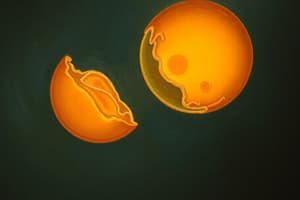Podcast
Questions and Answers
Explain the process of fertilization in human reproduction.
Explain the process of fertilization in human reproduction.
Fertilization (conception) is the fusion of a sperm and egg, which restores the diploid compliment of genetic material.
What are the three stages of semen release and their corresponding secretions?
What are the three stages of semen release and their corresponding secretions?
The three stages of semen release are before orgasm (small amount, bulbourethral gland secretions), during orgasm (majority release, seminal vesicle/prostate secretions), and after orgasm (small amount, seminal vesicle secretions).
What are the components of seminal plasma secretions from the sex accessory glands?
What are the components of seminal plasma secretions from the sex accessory glands?
The components of seminal plasma secretions include solvents, mucus, enzymes, energy sources, zinc, prostaglandins, and ATP.
What is the average number of sperm in a single ejaculation and the typical length of an individual sperm?
What is the average number of sperm in a single ejaculation and the typical length of an individual sperm?
What are the two types of twins and how do they originate?
What are the two types of twins and how do they originate?
What is parthenogenesis and in which organisms does it commonly occur?
What is parthenogenesis and in which organisms does it commonly occur?
What are the potential chromosomal aberrations that can occur due to errors in meiosis or fertilization?
What are the potential chromosomal aberrations that can occur due to errors in meiosis or fertilization?
What is the fate of most embryos with chromosomal aberrations?
What is the fate of most embryos with chromosomal aberrations?
What causes semen to thicken upon entry into the vaginal canal?
What causes semen to thicken upon entry into the vaginal canal?
What induces rhythmic contractions in the vagina that move sperm towards the cervix and uterus?
What induces rhythmic contractions in the vagina that move sperm towards the cervix and uterus?
What change in cervical mucus occurs around ovulation that allows sperm to pass into the uterus?
What change in cervical mucus occurs around ovulation that allows sperm to pass into the uterus?
What is the approximate number of sperm that make it through the cervix?
What is the approximate number of sperm that make it through the cervix?
What is necessary for sperm to survive in the reproductive tract for up to 6 days?
What is necessary for sperm to survive in the reproductive tract for up to 6 days?
When is fertilization most likely to occur?
When is fertilization most likely to occur?
What are the steps of fertilization that involve penetration of the cumulus oophorus, zona pellucida, attachment to the egg plasma membrane, cortical reaction, completion of meiosis II, and pronuclei generation?
What are the steps of fertilization that involve penetration of the cumulus oophorus, zona pellucida, attachment to the egg plasma membrane, cortical reaction, completion of meiosis II, and pronuclei generation?
What enzyme in sperm breaks down hyaluronic acid in the cumulus oophorus, allowing sperm to reach the zona pellucida?
What enzyme in sperm breaks down hyaluronic acid in the cumulus oophorus, allowing sperm to reach the zona pellucida?
What triggers the acrosome reaction in sperm, leading to the degradation of the zona pellucida?
What triggers the acrosome reaction in sperm, leading to the degradation of the zona pellucida?
What occurs in the egg after fertilization that removes extra DNA copies and creates the second polar body?
What occurs in the egg after fertilization that removes extra DNA copies and creates the second polar body?
What do the egg and sperm pronuclei do before fusing to create the zygote?
What do the egg and sperm pronuclei do before fusing to create the zygote?
What are the primary sex ratios for early aborted embryos and births?
What are the primary sex ratios for early aborted embryos and births?
Study Notes
Human Reproductive Biology: Fertilization and Sperm Transport
- Semen thickens upon entry into the vaginal canal, but liquefies again after 20 minutes, increasing vaginal pH to 7.2.
- Orgasm induces rhythmic contractions in the vagina which move sperm towards the cervix and uterus.
- Cervical mucus liquefies around ovulation allowing sperm to pass into the uterus, but only about 1 million sperm make it through the cervix.
- Sperm "climb" up the uterus aided by uterine contractions and cilia action, but many are targeted by macrophages.
- The oviduct acts as a temporary storage area for sperm, with many swimming past the ovulated egg.
- Capacitation and hyperactivation of sperm are necessary for fertilization, enabling them to survive in the reproductive tract for up to 6 days.
- Fertilization is most likely to occur in the 5 days before ovulation and the day of ovulation.
- Steps of fertilization involve penetration of the cumulus oophorus, zona pellucida, attachment to the egg plasma membrane, cortical reaction, completion of meiosis II, and pronuclei generation.
- Hyaluronidase in sperm breaks down hyaluronic acid in the cumulus oophorus, allowing sperm to reach the zona pellucida.
- Sperm recognition of a glycoprotein in the zona pellucida triggers the acrosome reaction, leading to the degradation of the zona pellucida.
- Completion of meiosis II in the egg after fertilization removes extra DNA copies and creates the second polar body.
- The egg and sperm pronuclei migrate towards each other, replicate their DNA, and fuse to create the zygote. The primary sex ratio is 120:100 for early aborted embryos and 105:100 for births.
Studying That Suits You
Use AI to generate personalized quizzes and flashcards to suit your learning preferences.
Related Documents
Description
Test your knowledge about the process of fertilization, including the fusion of sperm and egg, restoration of genetic material, and the physical and biochemical changes required for fertilization to occur.




